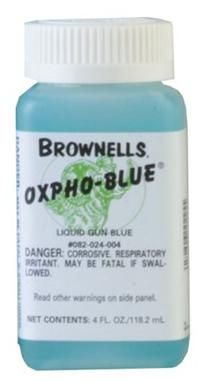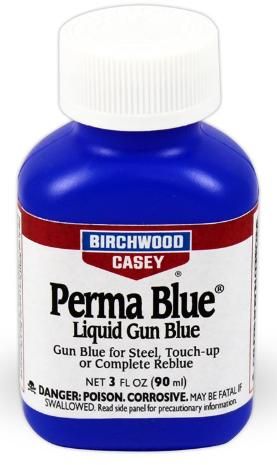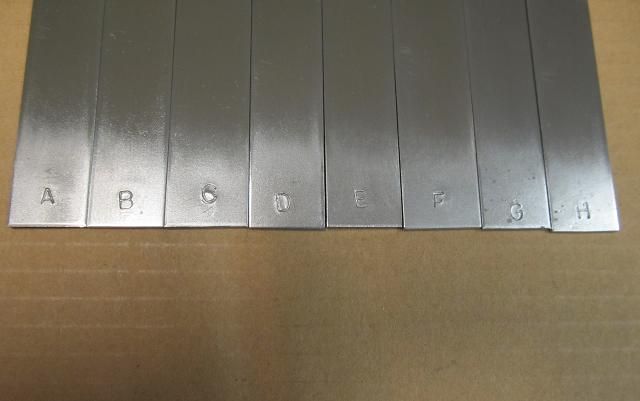If you have read any of my restoration threads you know I do a fair amount of cold bluing. I?ve gotten a few messages asking about the task and which cold blue is best. The thing is I really don?t know how to answer that since it?s hard to define best. Is it the lowest cost blue or the one that is easiest to apply or the one that color matches your gun the closest or is it the one that staves off corrosion the best or is it the one that does not wear off?? I don?t think there is one that meets all those criteria but I am willing to find out.
For most people, it might be the one that their local store carries so that?s all they have tried. At the same time there are questions from capable folks wanting to tackle their gun project but are uneasy about baring the metal and touching up or rebluing an entire gun out of fear (and the cost of a professional job) so they do nothing.
Since we learn by doing and improve by self reflection and because I too can get in a comfort zone with products I use, I decided to get a bunch of cold bluing products that are easy to find (the internet makes all of them easy to find) from local stores such as Gander Mtn and Cabelas and online from Brownells or at gun shows. All the products would be easily obtainable to somebody planning to do some bluing. I bought mostly known name brands (but not all of the brand as I don?t have unlimited time or money) to do an evaluation.
But first, a few things to get out of the way.
1. This is not a test. To call it such would be unfair to every test heretofore conducted. This is an evaluation and a comparison of several cold bluing products, nothing more, nothing less. If the cold bluing nirvana exists and it?s not part of the list of products I bought, then the best I can do is tell you about ones I am about to try.
2. I am not a pro. I am a hobbyist just like you but with some experience with metal, be It making custom knives or gun parts or gun restorations. I have a day job in the medical engineering field and metal and guns and knives are just relaxation. This evaluation is not for the experience bluer with a favorite product and special tricks to get a better blue job. This is for the novice contemplating trying bluing but confused by all the brands/claims available. This is not MY way of using blue but rather the Mfgr's instructions for using their blue.
3. I anticipate complaints and helpful comments about how I should have done this for better results. That is not the point of this evaluation. The average guy wont know special tricks and techniques to get better results and will only follow the instructions so if you have found better results by first coating the barrel in ketchup or lime-away or unicorn pee or only bluing during a full moon, that?s great info and I think folks would like to know your special tricks to achieve improved results (if you can quantify it with substance) but for the purposes of this evaluation it would be unfair to do anything but what the directions instruct.
4. I am not beholding to nor affiliated with any product or company I am about to mention. I?m just curious about cold bluing (and based on messages I have been getting, so are you.) I plan to be completely impartial since I have no reason to try to sway the results since I am hoping to find the best blue to use myself.
Enough prattle. The products I will be evaluating are (in no particular order)

Everything you want to learn about G96 can be found here.
http://www.g96.com/products/gun-blue-creme/#
Everything you want to learn about Oxpho-blue can be found here.
http://www.brownells.com/gunsmith-tools-supplies/metal-prep-coloring/metal-bluing/liquid-cold-bluing-chemicals/oxpho-blue-reg--prod1072.aspx
And this will educate you about Dicropan T4
http://www.brownells.com/gunsmith-tools-supplies/metal-prep-coloring/metal-bluing/liquid-cold-bluing-chemicals/dicropan-t-4--prod1085.aspx
Here is the link to Birchwood Casey Perma blue
http://www.midwayusa.com/product/419877/birchwood-casey-perma-blue-cold-blue-3-oz-liquid?cm_vc=ProductFinding
Birchwood Casey Super blue.
http://www.midwayusa.com/Product/284241/birchwood-casey-super-blue-cold-blue-3-oz-liquid
And Finally Nu-Blu from the Stock Doc. (which appears to only be available online or at gun shows. I bought mine a 2 weeks ago at a gun show from the Stock Doc booth.
http://stockdocusa.com/products.htmlI know what you?re thinking. ?Awe man he isn?t trying Brand X or brand Y and that?s what I use or can get my hands on.?
Sorry.
Ive asked my wife to assist me with this evaluation. She is always commenting on how we never spend enough time together. This will be a good bonding experience.
The sample metal sticks were all sheared from the same cold rolled steel sheet into manageable sample sizes

Then all were given a unique alpha identifier stamped into both sides that will be linked to the blue brand. You may have noticed there are more samples than there are bluing compounds. The extra samples will serve as a control since I plan to do a corrosion evaluation after bluing coupled with Birchwood Casey Barricade as well as an abrasion resistance evaluation. More on that later as I need to encourage my wife to work a little faster at the buffing wheel. You know, more work, less talk and make sure to lift with your back and that sort of positive encouragement.

A common theme in messages I have gotten is in regards to metal finish and metal prepping cleaning) and if mirror polishing is needed for a good bluing job. It been my experience that time spent prepping the metal is never wasted and a blue does not hide defects in metal finish, it actually makes them easier to see. So to that end, each sample is polished on one side and the other side gets a 400 grit brushed finish since that is comparable to the finish on many guns and any swinging Dick can buy 400 grit sandpaper and 0000 steel wool and produce that quality of finish on an entire gun or to spot remove rust from a portion of a gun. And because when I told my wife to polish both sides of the samples I had to dig one out of the drywall just to the left of my head. I think she has a little ninja in her.
Polishing was done on a very simple flannel buffing wheel with red rouge. Anybody with a bench grinder or drill press or even a hand held drill that lives near a hardware store can (if they desire) pick up a buffing wheel and buffing compound. The question is, is the repair you are doing next to metal that has a brushed finish or a polished finish because matching the blue won?t mean a darn thing if you don?t match the metal finish. Polishing a spot while the surrounding metal is brushed won?t match just like a rough finish surrounded by polished metal won?t match and no brand of blue can correct this.
Here are the samples viewing the polished side.

And the 400 grit brushed finish side.

Here is a very brief video of one of the samples so you can wrap your head around how they look prior to bluing. (I won?t win any awards for cinematography and yes I?m wearing Crocks (deal with it)
https://www.youtube.com/watch?v=oxEkvMCaFMAI read a lot of comments about what to clean the metal with prior to bluing. There are all sorts of ideas and ways to do this but simple is better. All you are trying to do is apply blue to clean metal that has no dirt, grease or oil to prevent bluing action. No need to get fancy. Acetone or denatured alcohol is all you need, hell hot soapy water with a rinse will do. You don?t need acids or etching media (because the blue will etch the metal just fine all by itself). None of the makers of bluing instruct users to use vinegar or acid or any other specialty product to etch or srip or clean the metal. While I understand that people are free to take additional steps in cleaning metal if they really think it helpful but I will be sticking to mfgr intructions for a fair evaluation.
All the metal samples for this evaluation were cleaned and degreased in the same manner. Acetone was used as the final degreaser because clean metal is paramount to a good blue job. Once cleaned, do not touch the metal with bare skin unless you like to see fingerprint spots where the bluing wont take. The chems you use for bluing are caustic poisons. Wear rubber gloves to protect you and the metal. (note. Not all rubber gloves will stand up to acetone)
Follow the instructions. Each bluing product comes with instructions for the best possible results. Follow them. All the blues I am about to evaluate were used according to their instructions. All stated that it should be applied, allowed to work and then rinsed off with water to neutralize the action of the bluing agent or simply wiped off. They all stated to buff/card the area blued with fine steel wool after bluing. Some but not all stated that additional applications may be needed to achieve a desired color or color match. Trust me ALL of them will require more than one application especially if you are doing a complete reblue. I will show you how each sample looks after just one application of blue and then I will apply 3 more applications for a total of 4.
**note I have been known to apply as many as 7 applications on guns I have worked on until I got the desired results**
The process will be
clean
blue (applied with cotton)
rinse with water and dry (or wipe dry)
buff with Steel wool
repeat 4 times with the last application of bluing applied with steel wool
One deviation from this SOP was made for the Stock Doc brand bluing (Nu-Blu) which called for heating the metal before applying the blue. I heated the metal with a propane heat source each time to a temp I could handle without burning my rubber glove covered hands. Again I am keeping with the instructions from the Mfgr to make sure each is getting a fair shot. Nu-Blu was the only blue which instructed me to heat the metal, The only other blue to mention heat was G96 and as you can see from the front label it states ?No heat required?. I know heat affects metal but I would think that if better results could be achieved with heat the Mfgr would instruct you to apply heat. Since Nu-Blu was the only one instructing to heat the metal, That is the only brand in which pre-heating was used.